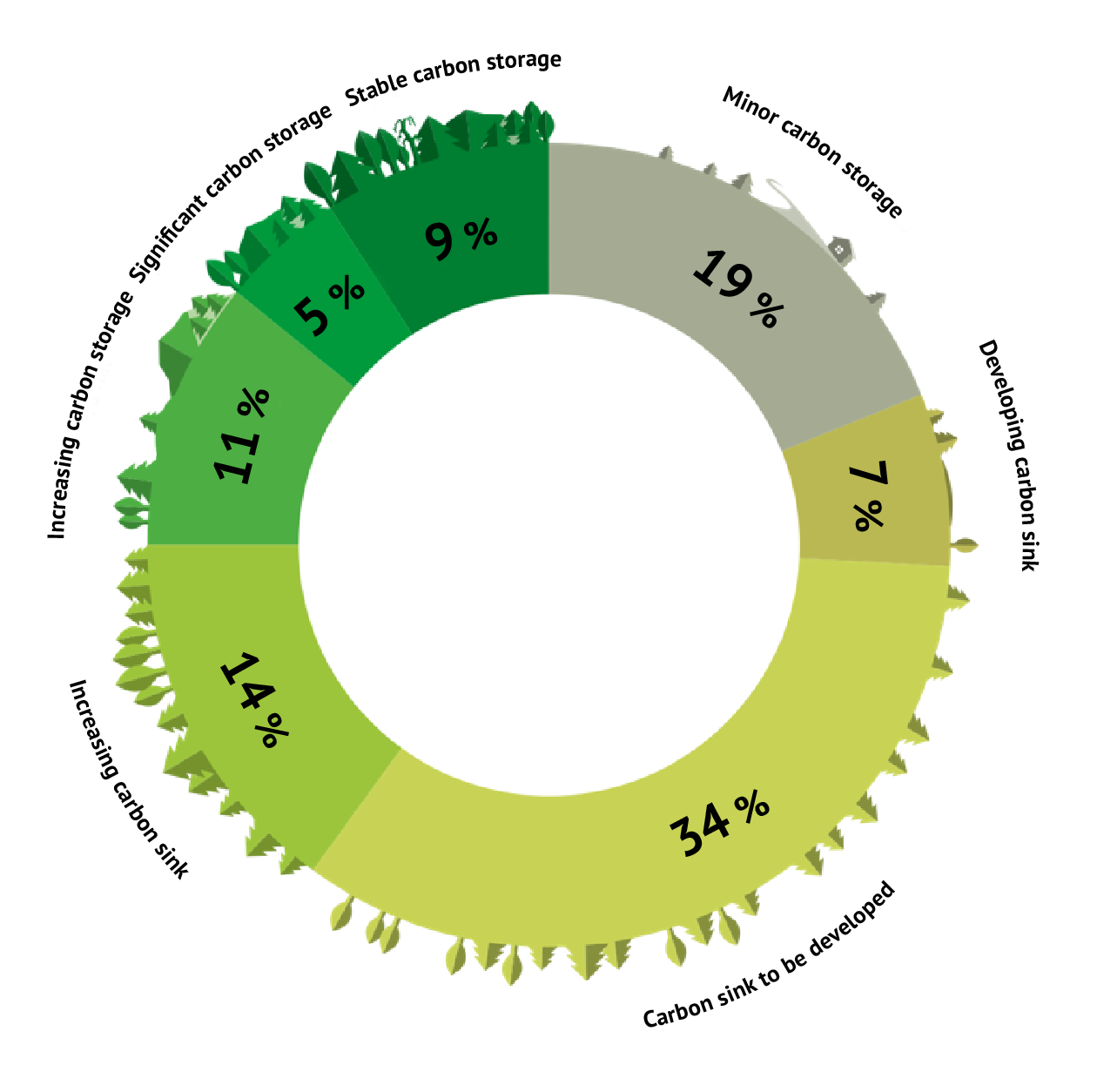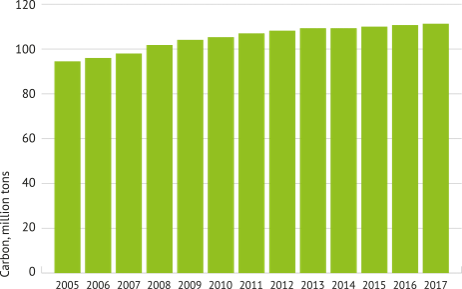Climate smart forestry is about techniques which bind and sequester carbon
Metsähallitus is committed to climate change mitigation and adaptation. In keeping with our Climate programme, which applies to all units of Metsähallitus, we aim to preserve carbon sinks and enhance carbon sequestration on state-owned lands by means of sound forest management practices and restoration.

Climate Smart Forestry in a nutshell
Climate Smart Forestry is about enhancing the sequestration and storage of carbon by forestry measures. They include fertilisation, drain maintenance, regeneration using improved seeds and seedlings, replanting as soon as possible after felling, regenerating underproductive forests, and afforestation.
Carbon sequestration can be promoted by prolonging the rotation period, continuous cover techniques on peatlands, and restoration of low-productivity drained mires. In areas with slower forest growth and on sites with special characteristics, the emphasis is on forests as carbon sinks.
The Climate Smart Forestry project (2017–2018) explored the impact of forestry measures on carbon sequestration and storage from a climate perspective. We examined how carbon sequestration and storage can be enhanced through forestry measures.
In this project, each of the ten million forest compartments in commercial multiple-use forests received a carbon classification describing its importance in terms of carbon sequestration and storage. Measures enhancing the sequestration of carbon include fertilisation, regeneration using improved seeds and seedlings, regenerating underproductive forests and afforestation. Techniques for enhancing carbon storage include prolonging the forest rotation period and restoring low-productivity mires.
Using the carbon classification, forest management can be geared more effectively towards climate change mitigation. In areas with rapid forest growth and intensive carbon sequestration, the focus will be on forest yield. In areas with slower forest growth and on sites with special characteristics, the emphasis is on forests as carbon sinks. While wood products replace plastic use, they also store carbon. This highlights the value of channelling timber to wood product manufacturing.
The additional information produced by
the project has been taken into account in Metsähallitus’ forest management
instructions, and they have also
been useful in the preparation of Metsähallitus’ Climate programme. In 2019,
the concept was developed further in a project called Climate Smart Forestry in
North Karelia. One of the new elements in this pilot project was examining the
carbon balance calculations of soil and trees as well as water table elevations
at the level of tree stands for the first time and including them in
Metsähallitus’ forest data. The method will be developed further, and the
implementation of the results will begin in 2020.
How do forests mitigate climate change?
Forests work as a carbon sink by binding atmospheric carbon dioxide through photosynthesis as they grow. The commercial forests managed by Metsähallitus play a major role as carbon sinks: their annual growth is 13 million cubic metres, whereas about six million cubic metres are felled each year.
Forests are an important carbon storage. When forest growth exceeds harvesting volumes, forests act as a carbon storage. In protected areas and areas of restricted forestry use where no harvesting take place, carbon is stored for long periods in both trees and the soil. Old-growth forests are in balance with regard to carbon sequestration: growing trees continue to bind carbon at a slow rate, while carbon is also slowly released as trees are decomposing.
Forests, renewable natural resources and renewable energy play an important role in replacing fossil alternatives. Some of the harvested timber will continue to act as a carbon sink in wooden buildings and other long-lasting products after processing.
Climate classification of forest compartments
The basic principle in the climate-wise classification of forest compartments is to define them as either carbon sinks or storages. While each group is important as a carbon sink and carbon storage, the management practices and forest use of the different categories vary. In general, compartments where forest use is restricted are treated as carbon storages, while compartments designated for normal forest use are treated as carbon sinks.
The Climate Smart Forest classification is based on Metsähallitus’ forest inventory, soil data, land use information and landscape-ecological data. The classification covers all forest compartments in Metsähallitus’ forestry areas. Forests in protected areas and national parks are not included. The figure below shows the number of forestry areas by category, 5,1 million hectares in total (includes forest land, low-productivity land, non-productive land, restricted forestry sites and nature sites.)
Carbon classification of forest compartments

Minor carbon storage (19%): Poor productivity, unproductive land or built-up land. The number of trees in these areas is so small that it has no significance as a carbon sink or storage, although the soil may still have such significance.

Developing carbon sink (7%): Young, growing stands and open areas which are only developing into good carbon sinks. Their age is over ten years in southern Finland and over 20 years in northern Finland. Their significance as a carbon sink and storage is small.

Carbon sink to be developed (34%): The number of trees or their growth are not ideal. Forest management is needed to improve carbon sequestration.

Increasing carbon sink (14%): The forest is in good condition, the number of growing trees is sufficient and forestry operations have been timely. These forests are the best carbon sinks in multiple-use forests.

Increasing carbon storage (11%): Areas where forestry use is restricted due to landscape, recreation or game management values or other similar reasons. Carbon sequestration is good and carbon storages in these areas are to be increased.

Significant carbon storage (5%): Areas where forestry use is restricted as in the previous category. The compartments contain plenty of carbon, but their capability of sequestering more, in other words functioning as carbon sinks, has decreased due to the ageing of the forest.

Stable carbon storage (9%): Areas completely excluded from forestry use, which develop according to natural processes and whose carbon storage may thus also decrease.
Distribution of forestry areas by carbon classification

Range of methods for climate-friendly forest management
In addition to carbon sequestration and storage, different measures’ significance for and impacts on soil carbon, biodiversity, water protection, business and recreational use, game, and reindeer husbandry were examined. A more detailed picture of the most important impacts of the measures was created using long-term felling calculations.
The carbon classification is a new tool used in conjunction with Metsähallitus’ forest management instructions and environmental guidelines. Each category has its own targets and recommendations for forest management and use. Methods used for carbon sequestration include such techniques as fertilisation, regeneration using selectively bred seeds and seedlings, regeneration of underproductive forests and afforestation. Methods used for carbon storage are improving forest density, prolonging the rotation period, restricting forestry operations to facilitate other forms of use and forest management to enhance coverage.
Carbon balance in forestry areas
We are building up carbon storage in state-owned forests.
The carbon balance in tree biomass has been growing more positive despite an increasing volume of timber harvesting. This increasingly positive carbon balance shows that Metsähallitus’ forest management instructions support carbon sequestration and storage. Focusing on carbon sequestration does not conflict with profitable forestry operations.

Progress can be made by emphasising climate considerations in forest management instructions and by further improving the standard of forest management. Climate Smart Forestry is part of Metsähallitus’ corporate social responsibility programme, and Metsähallitus will continue its efforts related to climate change mitigation.
The carbon classification will be developed further. In the future, soil carbon will be taken into account alongside forest carbon. We are actively following the progress of research in this field.